1. Early life and education
1.1. Birth and family background
Ante Pavelić was born on 14 July 1889 in the Herzegovinian village of Bradina, situated on the slopes of Ivan Mountain north of Konjic, approximately 9.3 mile (15 km) southwest of Hadžići. At the time, this region was part of the Ottoman Empire but under the administration of the Austro-Hungarian Empire. His parents had migrated to Bosnia and Herzegovina from the village of Krivi Put in the central Velebit plain, located in southern Lika (in modern-day Croatia). They moved to work on the Sarajevo-Metković railway line.
His family later moved to the village of Jezero outside Jajce in search of work, where Pavelić attended primary school, or maktab. During this period, he was exposed to Muslim traditions and lessons, which influenced his views on Bosnia and its Muslim population. His sense of Croat nationalism deepened after a visit to Lika with his parents, where he heard townspeople speaking Croatian, realizing it was not merely the language of peasants.
1.2. Education and early ideological influences
Pavelić's education was briefly interrupted in 1905 due to health problems. During the summer, he worked on the railway in Sarajevo and Višegrad. He continued his education in Zagreb, the home city of his elder brother Josip, where he attended high school. He failed to complete his fourth-year classes and had to retake the exam. Early in his high school years, he joined the Pure Party of Rights and the Frankovci students' organization, founded by Josip Frank, the father-in-law of Slavko Kvaternik, an Austro-Hungarian colonel. While attending school in Travnik, he became a fervent adherent of the nationalist ideologies of Ante Starčević and his successor as the leader of the Party of Rights, Josip Frank.
He later attended high school in Senj at the classical gymnasium, where he completed his fifth-year classes. Health issues again interrupted his studies, and he took a job on the road in Istria, near Buzet. In 1909, he finished his sixth-year classes in Karlovac, and his seventh-year classes were completed in Senj. Pavelić graduated in Zagreb in 1910 and enrolled in the Law Faculty of the University of Zagreb. In 1912, he was arrested on suspicion of involvement in the attempted assassination of the Ban of Croatia-Slavonia, Slavko Cuvaj. He completed his law degree in 1914 and earned his doctorate in July 1915. From 1915 until 1918, he worked as a clerk in the office of Aleksandar Horvat, who was the president of the Party of Rights. After completing his clerkship, he became a practicing lawyer in Zagreb.
2. Political career and exile
2.1. Early political activities
During World War I, Pavelić actively participated in the Party of Rights. As an employee and close associate of its leader, Aleksandar Horvat, he frequently attended important party meetings, often assuming Horvat's responsibilities in his absence. In 1918, Pavelić joined the party leadership and its Business Committee. Following the unification of the State of Slovenes, Croats and Serbs with the Kingdom of Serbia on 1 December 1918, the Party of Rights organized a public protest, asserting that the Croatian people opposed a Serbian king and that their highest state authorities had not consented to the unification. Furthermore, in a program issued in March 1919, signed by party president Vladimir Prebeg and Pavelić, the party expressed its desire for a Croatian republic.
In the 1921 local elections in Zagreb, Pavelić was elected as a member of the city assembly. Representing the party, he contacted Nikola Pašić, the Yugoslav Prime Minister and a member of the People's Radical Party, with the aim of weakening the Croatian Peasant Party (HSS), which was the dominant Croatian party during the interwar period. Pavelić was a member of the Frankovci faction of the Party of Rights. According to Ivica Peršić, a Croatian politician from the rival Milinovci faction, Pavelić's 1921 election significantly elevated the standing of his law office in Zagreb. He acquired numerous wealthy Jewish clients who paid him to obtain Yugoslav citizenship, leading Pavelić to make frequent visits to Belgrade to secure these documents through his growing connections within the ruling People's Radical Party.
In 1921, 14 members of the Party of Rights, including Pavelić, Ivo Pilar, and Milan Šufflay, were arrested for alleged anti-Yugoslav activities and contacts with the Croatian Committee, a Croatian nationalist organization based in Hungary at the time. Pavelić served as the defense lawyer during the subsequent trial and was eventually released.
On 12 August 1922, Pavelić married Maria Lovrenčević at St. Mark's Church, Zagreb. They had three children: daughters Višnja and Mirjana, and a son, Velimir. Maria had Jewish ancestry through her mother's family, and her father, Martin Lovrenčević, was a member of the Party of Rights and a well-known journalist. Pavelić later became the vice-president of the Croatian Bar Association, the professional body for Croatian lawyers.
In his speeches to the Yugoslav Parliament, Pavelić consistently opposed Serbian nationalism and advocated for Croatian independence. He was actively involved with the youth wing of the Croatian Party of Rights and contributed to the newspapers Starčević and Kvaternik. Serbian members of the Yugoslav Parliament disliked him, and when a Serbian member bid him "Good night," Pavelić famously retorted: "Gentleman, I will be euphoric when I will be able to say to you 'good night'. I will be happy when all Croats can say 'good night' and thank you, for this 'party' we had here with you. I think that you will all be happy when you don't have Croats here any more."
In 1927, Pavelić became the vice-president of the Party of Rights. In June 1927, he represented Zagreb County at the European Congress of Cities in Paris. Upon his return, he visited Rome and submitted a memorandum on behalf of the Party of Rights to the Italian Ministry of Foreign Affairs, offering cooperation with Italy in dismembering Yugoslavia. To secure Italian support for Croatian independence, the memorandum effectively proposed a future Croatia that would be little more than an Italian protectorate. It also recognized existing territorial settlements between Italy and Yugoslavia, thereby ceding all Croatian claims to Istria, Rijeka, Zadar, and the Adriatic islands that Italy had annexed after World War I. These areas were home to between 300,000 and 400,000 Croats. The memorandum further agreed to cede the Bay of Kotor and strategically important Dalmatian headlands to Italy and stipulated that a future Croatia would not establish a navy.
As the most radical politician of the Croatian Bloc, Pavelić sought opportunities to internationalize the "Croatian question" and emphasize Yugoslavia's inherent instability. In December 1927, he defended four Macedonian students in Skopje who were accused of belonging to the Macedonian Youth Secret Revolutionary Organization, founded by Ivan Mihailov. During the trial, Pavelić accused the court of fabricating charges and underscored the right to self-determination. This trial garnered significant public attention in both Bulgaria and Yugoslavia. Following his election as a member of the Croatian Bloc in the 1927 election, Pavelić became his party's liaison with Nikola Pašić. He was one of two elected Croatian Bloc candidates, alongside Ante Trumbić, a key figure in the creation of the Yugoslav state. From 1927 until 1929, he was part of the minuscule delegation of the Party of Rights in the Yugoslav Parliament.
In 1927, he secretly contacted the fascist dictator of Italy, Benito Mussolini, presenting his separatist ideas. Pavelić proposed an independent Greater Croatia that would encompass the entire historical and ethnic territory of the Croats. In mid-1928, the leaders of the Croatian Bloc, Trumbić and Pavelić, approached the Italian consul in Zagreb to gain support for the Croatian struggle against King Alexander's regime. On 14 July, they received a positive response, after which Pavelić maintained contact. Historian Rory Yeomans suggests there are indications that Pavelić had been considering the formation of a nationalist insurgency group as early as 1928.
After witnessing the assassination of Croatian politicians in the National Assembly, Pavelić joined the Peasant-Democratic Coalition and began publishing a magazine titled Hrvatski domobranCroatian (Croatian Home Guard), in which he advocated for Croatian independence. His political party became more radical following the assassination. He found support in the Croatian Rights Republican Youth (Hrvatska pravaška republikanska omladina), a youth wing of the Party of Rights led by Branimir Jelić. On 1 October 1928, he founded an armed group with the same name, an act through which he openly called on Croatians to revolt. This group trained as part of a legal sport society, but Yugoslav authorities declared the organization illegal and banned its activities.
2.2. Founding of the Ustaše movement
Pavelić held the position of the Party of Rights secretary until 1929, which marked the beginning of the 6 January Dictatorship in the Kingdom of Yugoslavia. After King Alexander declared his dictatorship, Pavelić's house was under constant police surveillance. At this time, Pavelić began organizing the Ustaše (Ustaša - Hrvatski revolucionarni pokret) as an organization based on military and conspiratorial principles. Its official foundation date was 7 January 1929. The Ustaše movement was "founded on the principles of racialism and intolerance," aiming to create an independent Croatia by any means, including terror.
2.3. Exile and collaboration with Axis powers
Due to the threat of arrest, Pavelić escaped during a lapse in surveillance and fled to Austria on the night of 19/20 January 1929. He then went to Vienna to "seek medical aid." He contacted other Croatian emigrants, primarily political émigrés and former Austro-Hungarian officers, who had gathered around Stjepan Sarkotić and refused to return to Yugoslavia. After a brief stay in Austria, Pavelić, accompanied by Gustav Perčec, moved to Budapest.
In March 1929, the Ustaše initiated a campaign of terrorism within Yugoslavia with the assassination of Toni Schlegel in Zagreb. Schlegel was a pro-Yugoslav editor of the newspaper Novosti and a close confidante of King Alexander. After establishing contact with the Internal Macedonian Revolutionary Organization in April 1929, Pavelić and Perčec traveled to Sofia, Bulgaria. On 29 April 1929, Pavelić and Ivan Mihailov signed the Sofia Declaration, formalizing cooperation between their movements and committing to separate Croatia and Macedonia from Yugoslavia. Yugoslavia protested to Bulgaria, and on 17 August 1929, Pavelić was found guilty of high treason and sentenced to death in absentia along with Perčec. Due to the Yugoslav verdict, Pavelić was arrested in Vienna on 25 September 1929 and expelled to Germany. His stay in Germany was restricted due to opposition from the German ambassador to Yugoslavia, Adolf Köster, who supported Yugoslavia and sought to prevent Croatian nationalist activities.
Pavelić left Germany using a false passport and went to Italy, where his family had already settled. In Italy, he frequently changed locations and lived under assumed names, most often as "Antonio Serdar." Having been in contact with Italian authorities since 1927, he easily re-established connections with the fascists. In autumn 1929, he made contact with Italian journalists and Mussolini's brother Arnaldo, who supported Croatian independence without territorial concessions. Pavelić successfully cultivated sympathy and understanding for Croats among Italians. That autumn, Pavelić published a brochure titled Establishment of the Croatian State: Lasting Peace in the Balkans, which summarized key events in Croatian history.
The Italian authorities, while not formally supporting the Ustaše to protect their reputation, nevertheless provided assistance to the group. Mussolini viewed them as a means to dismantle Yugoslavia and expand Italian influence in the Adriatic. He allowed Pavelić to reside in exile in Rome and train his paramilitaries for conflict with Yugoslavia. In the Ustaše organization of 1929-1930, Pavelić's closest associates included Gustav Perčec, Branimir Jelić, Ivan Perčević, and later Mladen Lorković and Mile Budak. The Ustaše began forming military units specifically trained for sabotage and terrorism.
With financial aid from Mussolini, Pavelić established terrorist training camps in 1931, initially in Bovegno in the Brescia region, and encouraged the creation of similar camps across Italy. Camps were also founded in Borgotaro, Lepari, and Janka-Puszta in Hungary. From these camps in Italy and Hungary, the Ustaše engaged in smuggling weapons and propaganda into Yugoslavia. At the insistence of Italian authorities, the camps were frequently relocated. The main Ustaše headquarters was initially in Torino and later in Bologna. At Pavelić's initiative, his associates established Ustaše associations in Belgium, the Netherlands, France, Germany, Argentina, Uruguay, Bolivia, Brazil, and North America. Pavelić also encouraged the publication of magazines in various countries.
The series of bombings and shootings perpetrated by the Ustaše in Yugoslavia led to a severe crackdown on political activity, with the state responding to terror with its own counter-terror measures. Impoverished Croat peasants were disproportionately affected by this counter-terror, which was often meted out by Serb policemen.
In 1932, Pavelić launched a newspaper called "Ustaša - Herald of Croatian Revolutionaries" (Ustaša - vijesnik hrvatskih revolucionaracaCroatian). From its very first issue, Pavelić explicitly stated that violence was central to the Ustaše's objectives, declaring: "The dagger, revolver, machine-gun and time bomb; these are the bells that will announce the dawn and the resurrection of the Independent State of Croatia." According to Ivo Goldstein, there was no antisemitism in the newspaper initially, attributing this to the Ustaše's sole focus on the Belgrade government, a lack of intellectual capacity within the early movement to develop such an ideology, and the active involvement of Jews with the Ustaše. However, Goldstein notes that Ustaše ideology became more antisemitic as it evolved in later years.
At a meeting held in Spittal, Austria, in 1932, Pavelić, Perčec, and Vjekoslav Servatzy decided to instigate a small uprising. This insurgency, known as the Velebit uprising, commenced at midnight on 6 September 1932. Led by Andrija Artuković, it involved approximately 20 Ustaše members armed with Italian equipment, who attacked a police station before retreating to Velebit without casualties. The aim of this uprising was to intimidate Yugoslav authorities. Despite its small scale, the Yugoslav authorities were unnerved due to their prior lack of knowledge regarding the Ustaše's capabilities, leading to the implementation of significant security measures. This event also received attention in the foreign press, particularly in Italy and Hungary.
On 1 June 1933 and 16 April 1941, the Ustaše program and "The Seventeen Principles of the Ustaše Movement" were published in Zagreb by the Propaganda Department of the Supreme Ustaše Headquarters. The primary objective was the creation of an independent Croatian state based on its historical and ethnic territories, with Pavelić asserting that the Ustaše would pursue this goal by any necessary means, including armed force. According to these principles, he would organize actions, assassinations, and diversions. With this document, the organization changed its name from Ustaša - Croatian Revolutionary Movement to Ustaša - Croatian Revolutionary Organization (Ustaša - Hrvatska revolucionarna organizacijaCroatian, abbreviated to UHRO).
2.4. Assassination of King Alexander I of Yugoslavia
Pavelić viewed the assassination of the King of Yugoslavia as an opportunity to incite riots and ultimately cause the collapse of the state. In December 1933, Pavelić ordered the assassination of King Alexander, but the attempt failed when the assassin was apprehended by police. However, Pavelić orchestrated another attempt in October 1934 in Marseille, France.
On 9 October 1934, King Alexander I of Yugoslavia and French foreign minister Louis Barthou were assassinated in Marseille. The perpetrator, Vlado Chernozemski, a Bulgarian revolutionary, was killed by French police immediately after the assassination. Three Ustaše members, positioned at different locations awaiting the king, were captured and sentenced to life imprisonment by a French court. Pavelić, along with Eugen Kvaternik and Ivan Perčević, were subsequently sentenced to death in absentia by the French court. The lax security, despite a previous attempt on Alexander's life, indicated Pavelić's organizational prowess, as he had apparently bribed a high official in the Sûreté General. The Marseilles Prefect of Police, Jouhannaud, was subsequently removed from office. The Ustaše believed that the assassination of King Alexander had effectively "broken the backbone of Yugoslavia" and considered it their "most important achievement."
Under pressure from France, Italian police arrested Pavelić and several Ustaše emigrants on 17 October 1934. Pavelić was imprisoned in Turin and released in March 1936. During a meeting with Eugen Dido Kvaternik in prison on Christmas 1934, Pavelić stated that assassination was "the only language Serbs understand." While incarcerated, Pavelić was informed about the situation in Yugoslavia and the 5 May 1935 election, in which a coalition of opposition parties was led by HSS leader Vladko Maček. Pavelić declared the election results a "success of the Ustaše actions." By the mid-1930s, graffiti with the initials ŽAP, meaning "Long live Ante Pavelić" (Živio Ante PavelićCroatian), began appearing on the streets of Zagreb.
After his release from prison, Pavelić remained under surveillance by Italian authorities, and his Ustaše followers were interned. Disappointed with the relationship between the Italians and the Ustaše organization, Pavelić gravitated towards Nazi Germany, which promised to revise the map of Europe established by the 1919 Treaty of Versailles. In October 1936, he completed a survey for the German Ministry of Foreign Affairs titled Croatian Question (Hrvatsko pitanjeCroatian; Die kroatische FrageGerman). According to Ivo Goldstein, the survey identified "Serbian state authorities, international Freemasonry, Jews and communism" as enemies, stating: "Today almost all banking and almost all trade in Croatia is in the hands of the Jews. This became possible only because the state gave them privileges, because the government believed that this would weaken Croatian national strength. The Jews greeted the foundation of the so-called Yugoslav state with great enthusiasm because a national Croatian state would never suit them as well as Yugoslavia did. ... All the press in Croatia is in Jewish hands. This Jewish Freemason press is constantly attacking Germany, the German people and national socialism."
According to Hrvoje Matković, after 1937, Pavelić shifted his focus more to the Ustaše within Yugoslavia, as the emigrants had become passive after the assassination. In 1938, he instructed the Ustaše to establish stations in Yugoslav towns. The fall of Stojadinović's government and the creation of the Banovina of Croatia in 1939 further stimulated Ustaše activity; they founded Uzdanica (Hope), a savings co-operative. Under Uzdanica, the Ustaše established Ustaše University Headquarters and the illegal association Matija Gubec. However, Stevan K. Pavlowitch notes that Pavelić had limited contact with the Ustaše inside Yugoslavia, and his esteemed position within the movement was partly due to his isolation in Italy. Despite their increased activity in the 1930s, the movement experienced only moderate growth in popularity and remained a marginal group.
In the late 1930s, approximately half of the 500 Ustaše in Italy were voluntarily repatriated to Yugoslavia, where they went underground and intensified their activities. During the strengthening of ties with Nazi Germany in the 1930s, Pavelić's concept of the Croatian nation became increasingly race-oriented.
On 1 April 1937, following the Stojadinović-Ciano agreement, all Ustaše units were dissolved by the Italian government. Subsequently, Pavelić was placed under house arrest in Siena, where he lived until 1939. During this period, he wrote his anti-Bolshevik work Horrors and Mistakes (Errori e orroriItalian; Strahote zabludaCroatian), which was published in 1938 but immediately seized by authorities. At the onset of World War II, he moved to a villa near Florence under police surveillance until spring 1941.
After Italy occupied Albania and prepared an attack on Yugoslavia, Ciano invited Pavelić for negotiations. They discussed a Croatian armed revolt, Italian military intervention, and the creation of a Croatian state with monetary, customs, and personal unions with Italy, a proposal Pavelić later rejected. In 1940, Pavelić negotiated with the Italians for military assistance to establish a separate Croatian state with strong ties to Italy, but this plan was postponed by the invasion of France and subsequently derailed by Adolf Hitler.
3. Establishment and rule of the Independent State of Croatia (NDH)
3.1. Proclamation of the NDH
On 25 March 1941, Yugoslavia signed the Tripartite Pact, but two days later, the government was overthrown in a bloodless military coup driven by various factors. Two days after the Belgrade coup, Mussolini invited Pavelić from Florence to his private residence in Rome, the Villa Torlonia; this was their first meeting since Pavelić's arrival in Italy. Pavelić was escorted by Matija Bzik, but Mussolini received only Pavelić, with Acting Foreign Minister Filippo Anfuso present during the meeting.
Pavelić and Mussolini discussed Croatia's position following Yugoslavia's capitulation. Mussolini was keen to secure Italian claims on Dalmatia, and Pavelić reaffirmed his earlier agreements, reassuring him. Pavelić requested the release of the remaining interned Ustaše, was assigned an Italian liaison officer, and was granted access to a radio station in Florence for late-evening broadcasts. On 1 April 1941, Pavelić called for the liberation of Croatia.
On 6 April 1941, the Axis powers invaded Yugoslavia from multiple directions, swiftly overwhelming the unprepared Royal Yugoslav Army, which capitulated 11 days later. The German operational plan included making "political promises to the Croats" to exacerbate internal discord. Generally, the Germans preferred to collaborate with non-fascists who were willing to work with them, resorting to outright fascists only as a last option. Croatia was no exception. The Nazis desired a Croatian puppet government with popular support to control their occupation zone with minimal forces and peacefully exploit resources. The administration of Banovina Croatia had been under an alliance of Vladko Maček's HSS and the predominantly Croatian Serb Independent Democratic Party. Maček, highly popular among Croats, had been vice-premier in the Yugoslav Cvetković government, supported Yugoslavia's accession to the Axis, and commanded a ready-made paramilitary force in the form of the HSS Croatian Peasant Defence. Consequently, the Germans attempted to persuade Maček to proclaim an "independent Croatian state" and form a government. When he refused to cooperate, the Germans, despite their reservations about the Ustaše's governing capabilities, decided they had no alternative but to support Pavelić.
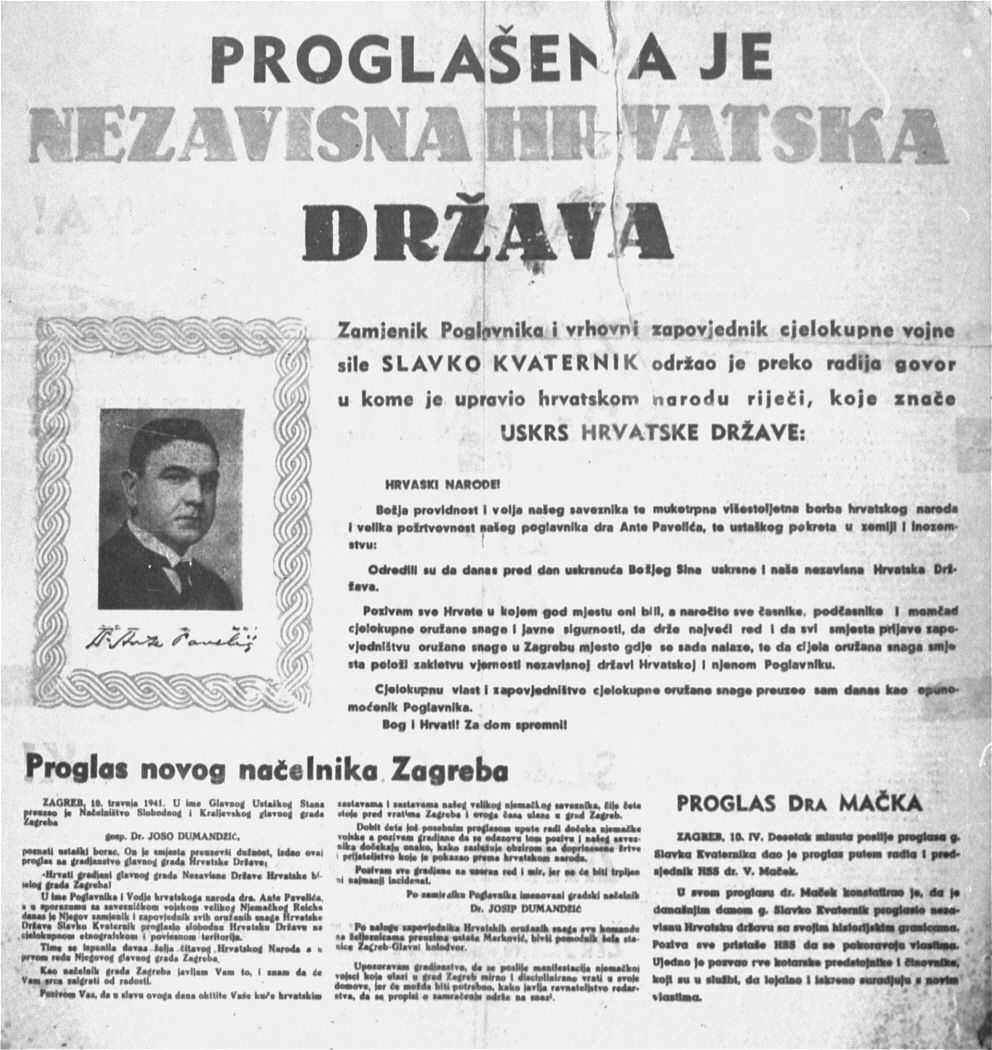
The Germans estimated that Pavelić had around 900 sworn Ustaše in Yugoslavia at the time of the invasion, and the Ustaše themselves believed their supporters numbered only about 40,000. The Germans also considered Pavelić an Italian agent or "Mussolini's man." However, they believed that other senior Ustaše, such as deputy leader (DoglavnikCroatian) Slavko Kvaternik, were sufficiently pro-German to ensure their interests would be supported by any regime led by Pavelić.
On 10 April 1941, Kvaternik, acting on the orders of SS-Brigadeführer (Brigadier) Edmund Veesenmayer, declared the establishment of an Independent State of Croatia in the name of the Poglavnik Ante Pavelić via the Zagreb Radio Station. The proclamation was met favorably by a significant portion of the population, particularly in Zagreb, western Herzegovina, and Lika. The Croatian Peasant Defence, which had been infiltrated by the Ustaše, assisted by disarming Royal Yugoslav Army units and establishing some control. However, the Ustaše received limited support from ordinary Croats, with the commander of German forces in the NDH estimating that only about 2% of the country's population supported the Ustaše regime.
The Ustaše who had been interned in Italy were concentrated at Pistoia, about 31 mile (50 km) from Florence, where they were issued Italian uniforms and small arms. Pavelić joined them on 10 April and listened to radio broadcasts announcing the proclamation of the NDH. This visit to Pistoia was Pavelić's first meeting with the Ustaše after the assassination in Marseilles. In Pistoia, Pavelić delivered a speech announcing that their struggle for an independent Croatia was nearing its end. He then returned to his home in Florence, where he heard Kvaternik's proclamation broadcast from Vienna. On 11 April, Pavelić traveled to Rome, where he was hosted by Anfuso and subsequently received by Mussolini. During their meeting, Pavelić was assured that his government would be recognized immediately upon his arrival in Zagreb.
After the meeting in Rome, Pavelić boarded a train with his Ustaše escort and traveled to Zagreb via Trieste and Rijeka. He arrived in Karlovac on 13 April with approximately 250 to 400 Ustaše, where he was greeted by Veesenmayer, who had been appointed by German Foreign Minister Joachim von Ribbentrop to supervise the state's creation. In Karlovac, Pavelić was asked to confirm that he had made no commitments to the Italians, but Mussolini's envoy arrived while he was there, and negotiations ensued to ensure that his messages to Hitler and Mussolini would satisfactorily address the questions of Dalmatia and recognition by the Axis powers. This issue was the first indication of Italo-German tensions over the NDH.
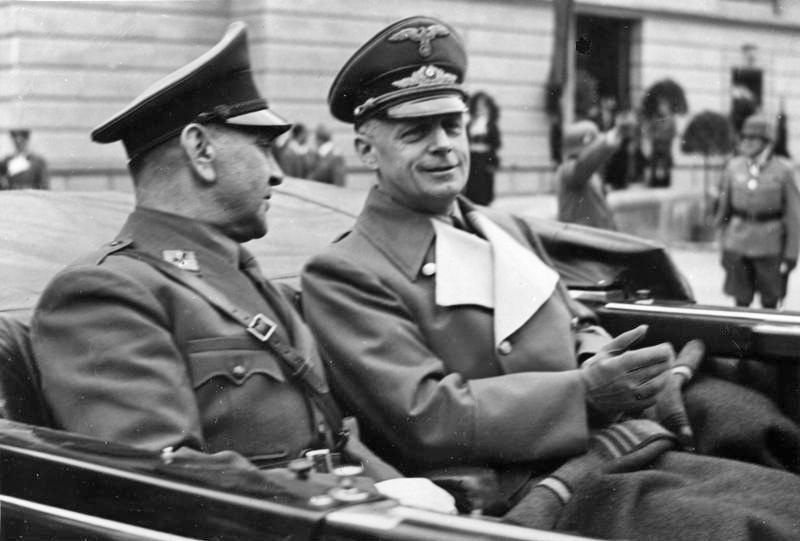
Diplomatic recognition of the NDH by the Axis was delayed to ensure that Pavelić made the promised territorial concessions to Italy. These concessions involved Pavelić ceding approximately 2.1 K mile2 (5.40 K km2) of territory with a population of 380,000 (consisting of about 280,000 Croats, 90,000 Serbs, 5,000 Italians, and 5,000 others) to Italy. Once this was completed, Pavelić traveled to Zagreb on 15 April, and Axis recognition was granted to the NDH on the same day.
On 16 April 1941, Pavelić signed a decree appointing the new Croatian State Government. He was the first to take an oath, after which he stated: "Since 1102, [the] Croatian people [haven't had an] autonomous and independent state. And there, after...839 years, the time has come to form [a] responsible Croatian government." Pavelić thus presented the NDH as the embodiment of the "historical aspirations of the Croatian people." The decree named Osman Kulenović as the vice-president of the government and Slavko Kvaternik as Pavelić's deputy, and appointed eight other senior Ustaše as ministers. The Ustaše utilized the existing bureaucracy of the Banovina of Croatia after it had been purged and "ustašised." The new regime drew upon the concept of an uninterrupted Croatian state since the arrival of the Croats in their contemporary homeland and reflected extreme Croat nationalism mixed with Nazism and Italian Fascism, Catholic clerical authoritarianism, and the peasantism of the Croatian Peasant Party.
Despite orchestrating anti-Serb atrocities, Pavelić remained a devoted Catholic, participating in mass in his chapel, worshipping, and confessing his sins.
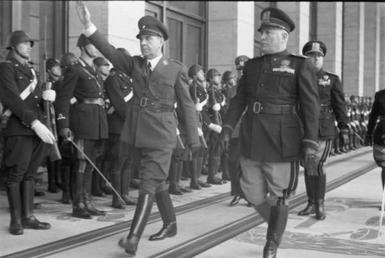
Pavelić attempted to prolong negotiations with Italy regarding the boundary between the two states, receiving support from Berlin at the time. Ciano insisted that Italy must annex the entire Croatian littoral, but after some time, the Germans withdrew their support to protect German-Italian relations. On 25 April, Pavelić and Ciano met again in Ljubljana to discuss borders. Ciano's initial proposal was for Italian annexation of the entire Croatian littoral and hinterland extending to Karlovac. Another proposal was less demanding but involved closer ties with Italy, including a monetary, customs, and personal union. Pavelić refused these proposals and instead demanded that Croatia gain the towns of Trogir, Split, and Dubrovnik. Ciano did not respond but promised another meeting. Pavelić continued to rely on German support, but without success.
On 7 May 1941, Pavelić and Mussolini met in Tržič and agreed to discuss the matter in Rome. On 18 May 1941, Pavelić traveled to Rome with his delegation and signed the Treaty of Rome, in which Croatia ceded parts of Dalmatia, Krk, Rab, Korčula, Biograd, Šibenik, Trogir, Split, Čiovo, Veliki and Mali Drvenik, Šolta, Mljet, and parts of Konavle and the Bay of Kotor to Italy. A Croatian proposal for joint administration of Split and Korčula Island was ignored. These annexations shocked the populace and led to the only recorded public demonstration in the history of the Independent State of Croatia, when hundreds of citizens, members of the Ustaše Movement, and the Domobranstvo (Army) protested on 25 December 1941. Pavelić attempted to reclaim the lost areas but concealed his true feelings and those of the people from the Italians to maintain the facade of good relations.
3.2. Role as Poglavnik and dictatorial rule
Pavelić agreed to name Prince Aimone, Duke of Spoleto, as King of Croatia to avoid a union with the Kingdom of Italy, but he delayed the formalities in the hope of gaining more territory in exchange for accepting the new king. Aimone was officially declared King of the Independent State of Croatia on 18 May 1941 under the name of Tomislav II, and he appointed Pavelić as Prime Minister. In March 1942, Aimone succeeded his brother to become the 4th Duke of Aosta. However, the King's powers were purely ceremonial, to the extent that he never even visited Croatia during his reign, preferring to conduct his royal duties from an office in Rome. On 10 July 1941, Pavelić accepted the annexation of Međimurje by Hungary.
As Prime Minister of the NDH, Pavelić wielded absolute control over the state. The oath taken by all government employees declared that Pavelić represented the sovereignty of the NDH. His title Poglavnik underscored the close ties between the Croatian state and the Ustaše movement, as he held the same title as the leader of the Ustaše. Furthermore, Pavelić made all significant decisions, including appointing state ministers and leaders of the Ustaše. Since the NDH had no functional legislature, Pavelić personally approved all laws, making him the most powerful figure in the state. Through the incorporation of the extreme right-wing of the popular HSS, Pavelić's regime was initially accepted by the majority of Croats in the NDH. The regime also attempted to rewrite history by falsely claiming the legacy of HSS founder Stjepan Radić and Croatian nationalist Ante Starčević.
Soon after, Pavelić visited Pope Pius XII in May 1941, seeking Vatican recognition, but he failed (although the Papacy did place a legat in Zagreb). The Vatican maintained relations with the Yugoslav Government-in-exile.
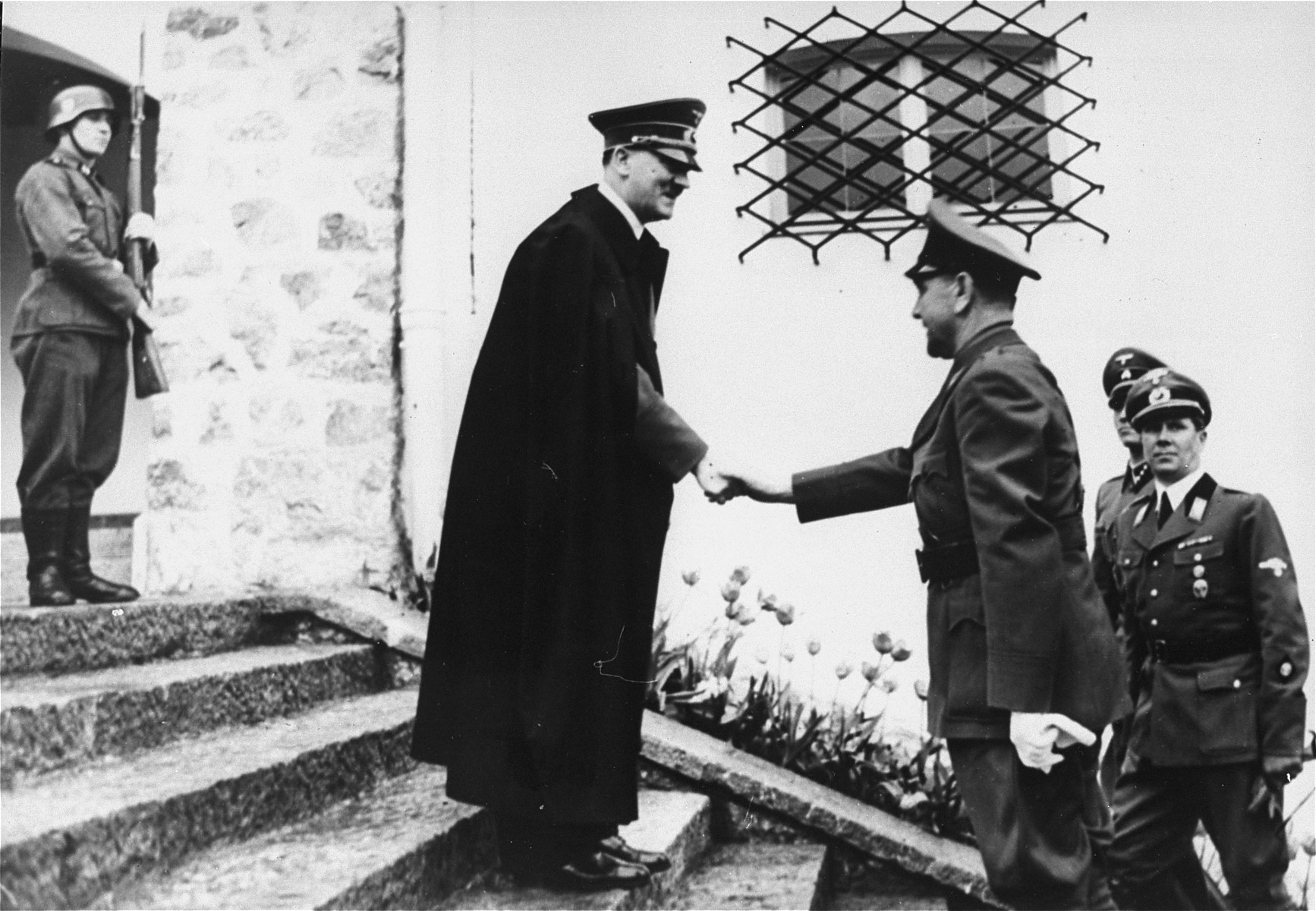
On 9 June 1941, Pavelić visited Hitler at the Berghof. Hitler impressed upon Pavelić that he should maintain a policy of "national intolerance" for fifty years. Hitler also encouraged Pavelić to accept Slovenian immigrants and deport Serbs to the Territory of the Military Commander in Serbia. Over the next few months, the Ustaše deported approximately 120,000 Serbs.
In July 1941, the German Plenipotentiary General in the NDH, Generaloberst Edmund Glaise von Horstenau, met with Pavelić to express his "grave concern over the excesses of the Ustaše." This was the first of many occasions over the next three years during which von Horstenau and Pavelić clashed over the conduct of the Ustaše. By the end of 1941, the initial acceptance of the Ustaše regime by most Croats had transformed into disappointment and discontent. As a result of the terror perpetrated by the regime, some pro-Yugoslav sentiment began to re-emerge, alongside pro-communist feelings. The discontent worsened when Pavelić had Vladko Maček arrested and sent to Jasenovac concentration camp in October 1941. By the end of 1941, HSS propaganda leaflets were urging peasants to be patient as the "day of liberation is near!"
In the public sphere, there were concerted efforts to create a cult of personality around Pavelić. These efforts included the imposition of a Nazi-style salute, emphasizing that he had been sentenced to death in absentia by a Yugoslav court, and repeatedly claiming that he had endured great hardship to achieve the independence of the NDH. Pavelić convened the Sabor on 24 January 1942. It met between 23 and 28 February, but it had little influence and was never called again after December 1942.
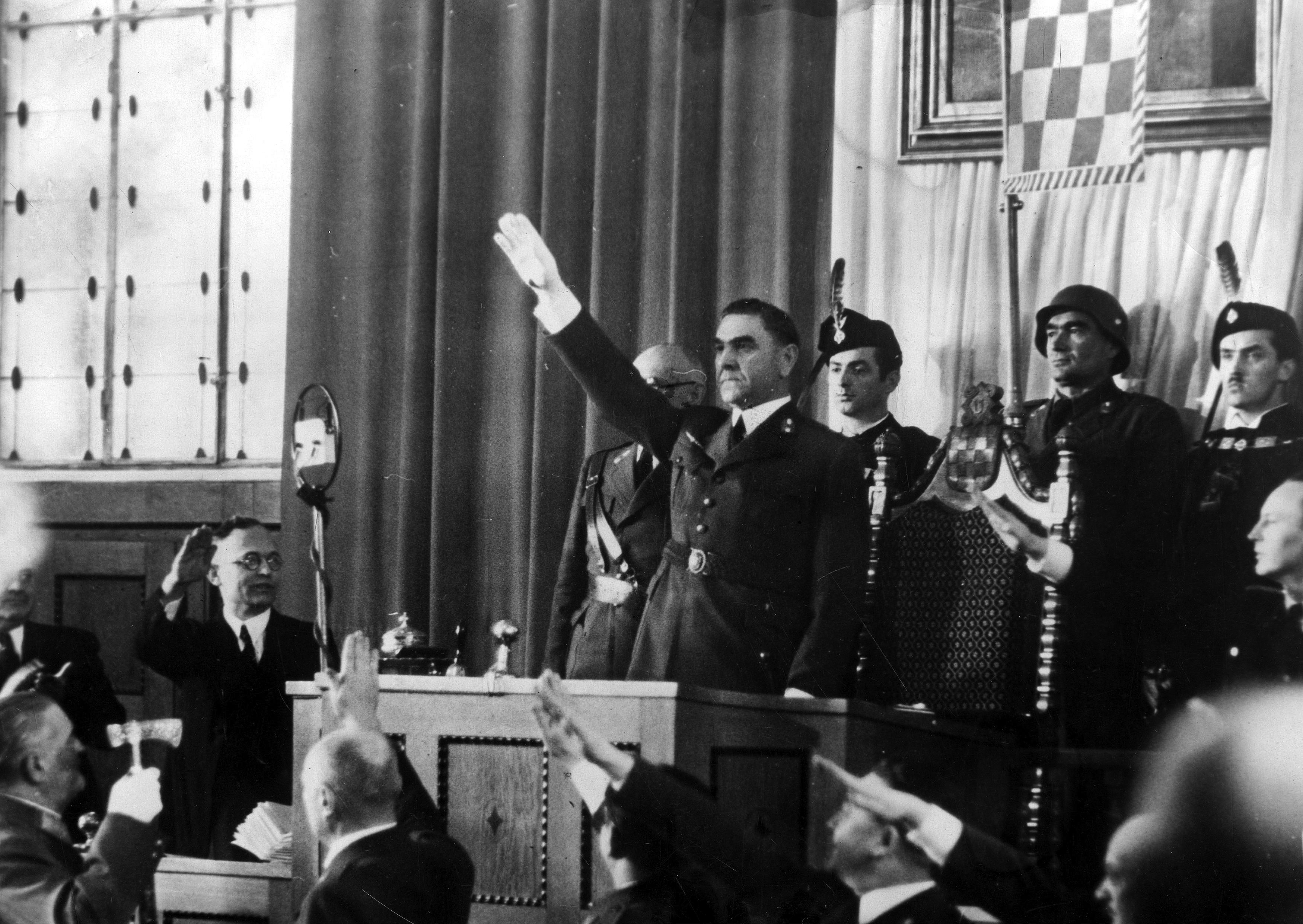
On 3 March 1942, Hitler awarded Pavelić the Grand Cross of the Order of the German Eagle. Siegfried Kasche, the German envoy, presented it to him in Zagreb. Eugen Dido Kvaternik, son of Slavko Kvaternik and one of the main perpetrators of the Ustaše genocide against the Serbs, stated that Pavelić directed Croat nationalism against the Serbs to distract the Croat population from a potential backlash against the Italians over his territorial concessions in Dalmatia. The most brutal policies directed against minorities were implemented through Ustaše-run concentration and forced labor camps. The most notorious camp was the Jasenovac concentration camp, where an estimated 80,000 to 100,000 people died, including around 18,000 Croatian Jews, representing approximately 90% of the pre-World War II Jewish community.
Pavelić founded the Croatian Orthodox Church with the aim of pacifying the Serbs. However, the underlying ideology behind its creation was linked to the ideas of Ante Starčević, who considered Serbs to be "Orthodox Croats," reflecting a desire to create a Croatian state comprising three main religious groupings: Roman Catholic, Muslim, and Croatian Orthodox. There is some evidence that the status of Sarajevo Serbs improved after significant numbers joined the Croatian Orthodox Church. Through both forcible and voluntary conversions between 1941 and 1945, 244,000 Serbs were converted to Catholicism.
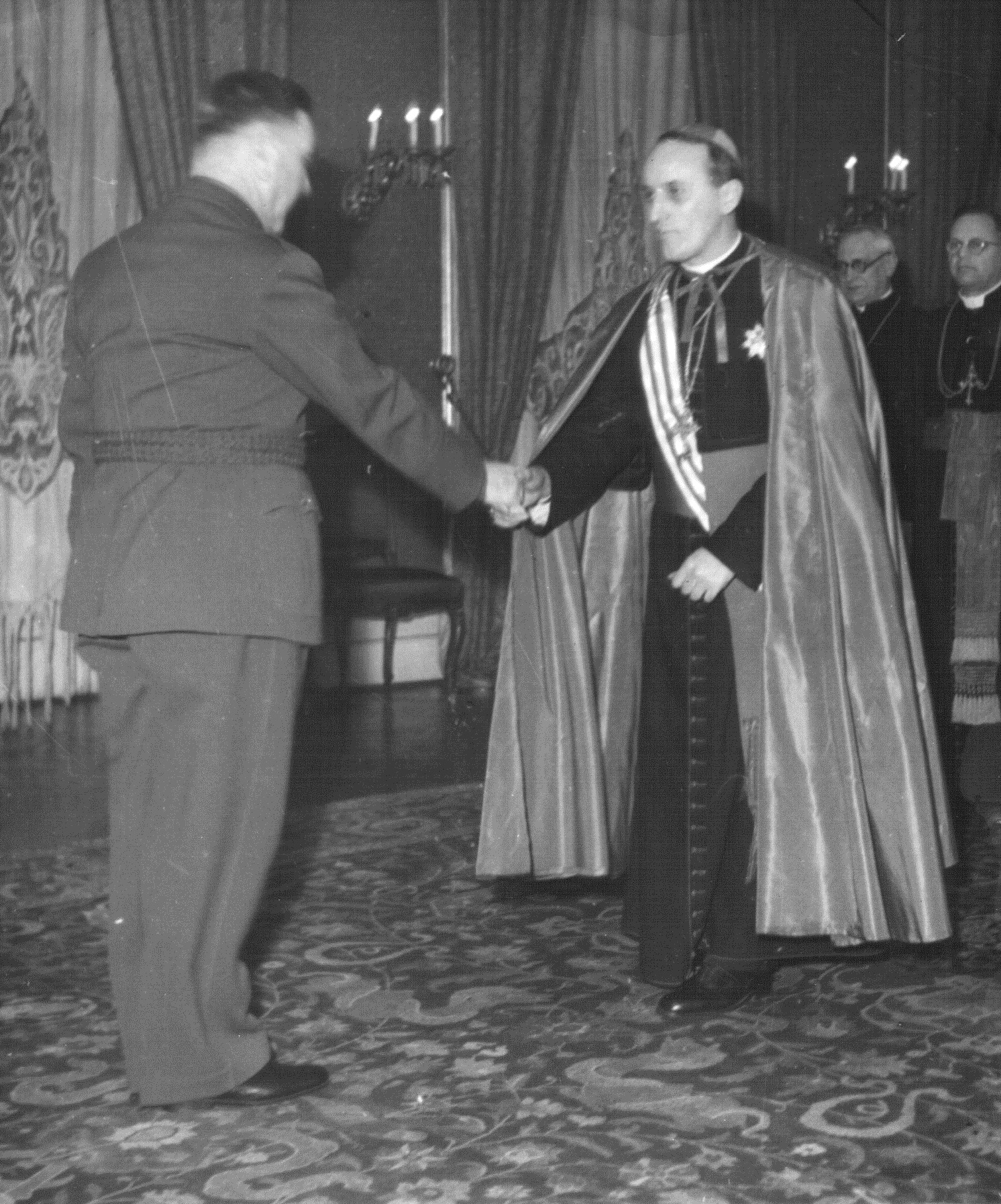
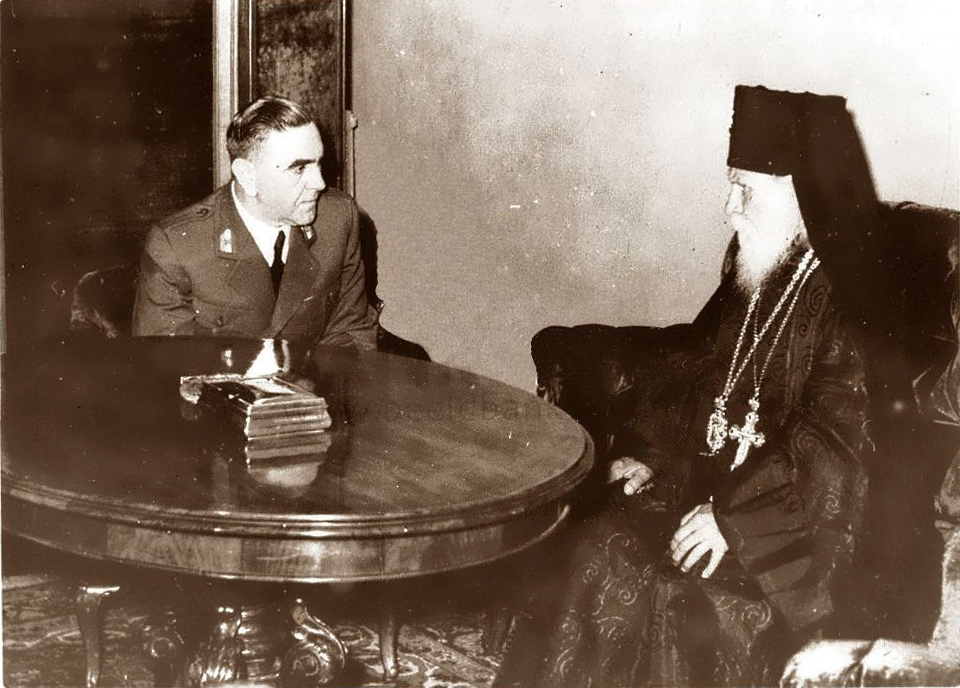
In June 1942, Pavelić met with General Roatta, and they agreed that Ustaše administration could be reinstated in Zone 3, except in towns with Italian garrisons. Pavelić consented to the continued presence of the Chetnik Anti-Communist Volunteer Militia in this zone and that the Italians would intervene in Zone 3 if they deemed it necessary. This agreement resulted in Italian forces largely withdrawing from areas where the NDH had virtually no presence and no means to re-impose its authority. This created a wide no-man's land stretching from the Sandžak to western Bosnia, where Chetniks and Partisans could operate. By mid-1942, Pavelić's regime effectively controlled only the Zagreb region and some larger towns that hosted strong NDH and German garrisons.
Pavelić loyalists, primarily Ustaše, sought to combat the Communist-led partisans, while others, unnerved by the prospect of a new Yugoslavia, also supported him. In 1941-42, the majority of Partisans in Croatia were Serbs, but by October 1943, the majority were Croats. This shift was partly due to the decision of a key Croatian Peasant Party member, Božidar Magovac, to join the Partisans in June 1943, and partly due to the capitulation of Italy.
Pavelić and his government also focused on culture. Although much literature served as propaganda, many books lacked an ideological basis, allowing Croatian culture to flourish. The Croatian National Theatre hosted many world-famous actors. A significant cultural achievement was the publication of the Croatian Encyclopedia, a work later outlawed under the Communist regime. In 1941, the Croatian Football Association joined FIFA.
On 16 December 1941, Pavelić met with Italian Foreign Minister Ciano in Venice and informed him that no more than 12,000 Jews remained in the NDH. In the second half of 1942, the Wehrmacht Commander-in-Chief of the South East, Generaloberst Alexander Löhr, and Glaise urged Hitler to have Pavelić remove both the incompetent Slavko Kvaternik and his son, the brutal Eugen "Dido" Kvaternik, from power. When Pavelić visited Hitler in Ukraine in September 1942, he agreed. The following month, Slavko Kvaternik was permitted to retire to Slovakia, with Eugen accompanying him. Pavelić then used the Kvaterniks as scapegoats for both the terror of 1941-42 and the failure of NDH forces to establish law and order within the state.
In January 1943, Glaise informed Pavelić that it would be beneficial for all if "all concentration camps in the NDH were closed and their inmates sent to work in Germany." Löhr also attempted to persuade Hitler to remove Pavelić, disband the Ustaše, and appoint Glaise as plenipotentiary general with supreme authority over the NDH territory. By March, Hitler had decided to assign the task of pacifying the NDH to Reichsführer-SS (Field Marshal) Heinrich Himmler, who appointed his own plenipotentiary, Generalleutnant der Polizei (Major General of Police) Konstantin Kammerhofer. Kammerhofer brought the 7th SS Volunteer Mountain Division Prinz Eugen to the NDH and established a 20,000-strong German gendarmerie with a core of 6,000 Volksdeutsche reinforced by Croats drawn from the NDH Home Guard and police. This new gendarmerie swore allegiance to Hitler, not Pavelić.
Shortly before the Italian capitulation, Pavelić appointed a new government led by Nikola Mandić as prime minister, which included Miroslav Navratil as Minister of the Armed Forces. Navratil, suggested by Glaise, was appointed by Pavelić to appease the Germans. As a direct result, the 170,000-strong armed forces of the NDH were reorganized under German control into smaller, more mobile units, and the size of the Ustaše militia was also increased to 45,000.
In September 1944, Pavelić met with Hitler for the last time. Pavelić requested that the Germans cease arming and supplying Chetnik units and asked that the Germans disarm the Chetniks or permit the NDH to do so. Hitler agreed that the Chetniks could not be trusted and issued orders to German forces to stop cooperating with them and assist NDH authorities in disarming them. However, German commanders were given sufficient discretion to avoid carrying out these orders.
3.3. Government structure and policies
Following the fall of Fascism in Italy, Tomislav II abdicated as King of Croatia on the orders of Victor Emmanuel III. With the King officially gone, Pavelić assumed the functions of Head of State of the NDH under the title of Poglavnik and appointed Nikola Mandić as the new prime minister. Italy was subsequently invaded and occupied by the Germans in Operation Achse.
As soon as the Italians capitulated in September 1943, Pavelić swiftly integrated Italian-annexed Dalmatia into the NDH and offered amnesty to Croats who had joined the rebels. However, the Germans themselves occupied the previously Italian-controlled zone, including the mines and key agricultural areas. By November 1943, Pavelić and his regime controlled little of the territory of the NDH. By March 1944, SS-Brigadeführer und Generalmajor der Waffen-SS (Brigadier) Ernst Fick observed that "In terms of power, Dr. Ante Pavelić is only mayor of the city of Zagreb, excluding the suburbs."
One of the key events in the history of the Independent State of Croatia was the Lorković-Vokić coup of 1944. Minister Mladen Lorković and army officer Ante Vokić proposed a plan for Croatia to switch sides in the war, with Pavelić stepping down as head of state in accordance with British demands. Initially, Pavelić supported their ideas but changed his mind following a visit from a local Gestapo officer who assured him that Germany would win the war with new weapons under development. Pavelić subsequently arrested Lorković and Vokić, along with others involved in the coup, including representatives of the Croatian Peasant Party and a number of Domobran officers. Lorković and Vokić were shot at the end of April 1945 in the Lepoglava prison. After plans for an "Anglo-American" coup were uncovered, from September 1944 until February 1945, Pavelić negotiated with the Soviet Union. The Soviets agreed to recognize the Croatian state on condition that the Red Army had free access and Communists were allowed free rein. Pavelić refused their proposal and remained allied with Nazi Germany until the end of the war.
3.4. Ideological basis of the regime
The Ustaše regime was founded on principles of extreme Croat nationalism, fascism, and clericalism. Pavelić's ideology, which became increasingly race-oriented, sought to create a "Greater Croatia" encompassing historical and ethnic Croatian territories, including much of Bosnia and Dalmatia. The regime implemented a system of racial laws, defining non-Aryan citizens as stateless, prohibiting inter-ethnic marriages, and excluding non-Aryans from social, cultural, and professional organizations. This ideology fueled a systematic campaign of violence and extermination against targeted populations, particularly Serbs, Jews, and Roma, who were deemed enemies of the state. The regime also attempted to create a cult of personality around Pavelić, emphasizing his perceived hardships in achieving Croatian independence and imposing Nazi-style salutes. Efforts were made to rewrite historical narratives, falsely claiming the legacy of Croatian nationalist figures like Stjepan Radić and Ante Starčević to legitimize the Ustaše's authoritarian rule.
3.5. Territorial concessions and relations with Axis powers
The Independent State of Croatia, though claiming to represent a "Greater Croatia," was forced by its Axis patrons to make significant territorial concessions. The Treaty of Rome, signed with Italy in May 1941, saw the cession of substantial parts of Dalmatia, including several islands and coastal areas, to Italy. These concessions were deeply unpopular within Croatia and led to public protests. Despite these territorial losses, Pavelić maintained a complex and often subservient relationship with both Fascist Italy and Nazi Germany. While seeking their support for Croatian independence, he was compelled to align his regime's policies with their broader strategic and ideological goals, particularly regarding racial persecution and the suppression of dissent. The Axis powers, especially Germany, exerted considerable influence over the NDH's internal affairs, at times even expressing concern over the extreme brutality of the Ustaše.
4. Genocide and persecution
4.1. Ustaše Ideology and Genocidal Policies
The core ideological drivers of the Ustaše regime were rooted in extreme ultranationalism, racialism, and antisemitism. Pavelić and the Ustaše asserted a fabricated historical narrative that claimed Croats were of Aryan descent, thereby justifying the systematic persecution and extermination of non-Aryan populations within the NDH. This racialist worldview, combined with a fervent anti-Serb sentiment, formed the basis for their genocidal policies. Pavelić openly declared his intent to eliminate the Serb population, stating in an interview with Italian journalist Alfio Russo in late April 1941 that Serb rebels would be killed, and when asked "what if all Serbs rebel?", he responded, "We shall kill them all." The regime's policies were designed to create a racially "pure" Croatian state, leading to the implementation of discriminatory laws and the establishment of a vast apparatus for mass murder.
4.2. Campaign of Terror and Mass Atrocities
The Ustaše regime unleashed a systematic campaign of violence and terror across the Independent State of Croatia. Early mass atrocities, such as the Gudovac massacre, Veljun massacre, and Glina massacre, were committed by Ustaše groups under the direct command of Vjekoslav Luburić. These massacres involved brutal methods, including hacking to death Serbian, Jewish, and Romani men, women, and children. Entire villages were razed, and people were driven into barns that the Ustaše then set on fire. Synagogues were also destroyed, most notably the main one in Zagreb, which was completely demolished. German officials frequently expressed alarm at the scale of Ustaše brutality. General Edmund Glaise-Horstenau reported to the German Army Command OKW on 28 June 1941 that "according to reliable reports from countless German military and civil observers during the last few weeks the Ustaše have gone raving mad." On 10 July, Glaise-Horstenau further noted: "Our troops have to be mute witnesses of such events; it does not reflect well on their otherwise high reputation... I am frequently told that German occupation troops would finally have to intervene against Ustaše crimes. This may happen eventually. Right now, with the available forces, I could not ask for such action. Ad hoc intervention in individual cases could make the German Army look responsible for countless crimes which it could not prevent in the past." A report to SS chief Heinrich Himmler, dated 17 February 1942, explicitly stated that "Increased activity of the bands is chiefly due to atrocities carried out by Ustaše units in Croatia against the Orthodox population." The Ustaše committed their crimes not only against males of conscript age but particularly against helpless elderly people, women, and children.
4.3. System of Concentration Camps
Under Pavelić's regime, a horrific system of concentration camps was established and operated throughout the NDH. The most infamous of these was the Jasenovac concentration camp, a complex of five sub-camps, which served as a site for detention, forced labor, and mass murder of civilians. Other notable camps included Stara Gradiška. These camps were central to the Ustaše's genocidal policies, designed to systematically eliminate targeted populations.
4.4. Persecution and Extermination of Serbs
The genocidal policies of the Ustaše regime were primarily directed at the Serb population within the NDH. The regime viewed Serbs as an existential threat to the "pure" Croatian state and initiated a brutal campaign of mass killings and forced conversions. Estimates of Serb victims range from 172,000 to 290,000 killed by the Ustaše and their Axis allies. The methods employed were exceptionally cruel, including massacres, torture, and forced displacement. This systematic extermination campaign has been described as the "single most disastrous episode in Yugoslav history." Pavelić himself articulated a policy of "one-third conversion, one-third expulsion, and one-third extermination" for the Serb population.
4.5. Persecution and Extermination of Jews
The Ustaše regime implemented a comprehensive set of antisemitic laws, mirroring those of Nazi Germany, which led to the systematic persecution and extermination of the Jewish population within the Independent State of Croatia. These laws included the 'Decree-Law concerning the Preservation of Croatian National Property' (April 1941) which annulled Jewish property transactions, the 'Law concerning Nationality' (April 1941) which effectively stripped Jews of citizenship, and further restrictions on their movement and residency. From 23 May 1941, all Jews were forced to wear yellow identification tags. On 26 June, Pavelić issued a decree blaming Jews for activities against the NDH and ordering their internment in concentration camps. Approximately 31,000 of the 40,000 Jews in the NDH were killed, with around 18,000 dying at Jasenovac alone, representing about 90% of the pre-World War II Jewish community in Croatia. According to an official Yugoslav report, only 1,500 out of 30,000 Croatian Jews survived by the end of World War II.
4.6. Persecution and Extermination of Roma
The Roma population within the NDH was also systematically targeted for persecution and mass murder, an atrocity often referred to as the Porajmos. The Ustaše regime's racial ideology extended to the Roma, leading to their widespread internment and extermination. Between 25,000 and 40,000 Roma were killed, with approximately 26,000 murdered by the Ustaše and their allies.
4.7. Persecution of Anti-fascists and Political Opponents
Beyond ethnic and religious minorities, the Ustaše regime brutally repressed and killed political opponents, including Croatian anti-fascists, members of the Croatian Peasant Party, and other dissidents who opposed the authoritarian rule. Many were subjected to imprisonment, torture, and execution. An estimated 26,000 Croatian anti-fascists (Partisans, political opponents, and civilians) were killed by the NDH regime, including an estimated 5,000 to 12,000 Croat anti-fascists and other dissidents who perished at the Jasenovac concentration camp alone.
4.8. Scale and International Reaction
The scale of atrocities committed by the Pavelić regime was immense. Estimates indicate that between 172,000 and 290,000 Serbs, 31,000 of the 40,000 Jews, and almost all of the 25,000 to 40,000 Roma were killed in the Independent State of Croatia by the Ustaše and their Axis allies. The regime's brutality was so extreme that it even drew concerns from its German allies. German officials, including General Edmund Glaise von Horstenau, repeatedly expressed "grave concern over the excesses of the Ustaše" and attempted to restrain Pavelić and his genocidal campaign. Despite these concerns, the Ustaše's reign of terror continued largely unchecked by the Axis powers, highlighting the regime's profound disregard for human life.
5. End of the war and post-war life
5.1. Collapse of the NDH and flight
As Germany faced collapse and it became clear that the Croatian army could not withstand the advancing Communist forces, Pavelić initiated a movement of his troops towards Austria. This decision led to a mass exodus of tens of thousands of Croatian soldiers and civilians, who began a major northward march without a clear strategic plan. Pavelić himself left the country on 6 May 1945. On 8 May, he convened a final meeting of the NDH government in Rogaška Slatina. At this meeting, General Alexander Löhr informed the government of Germany's capitulation and formally handed command of the NDH forces to Pavelić. Pavelić subsequently named General Vjekoslav Luburić as commander. Later that day, Pavelić's convoy entered the Soviet occupation zone in Austria, separating from the rest of the NDH government, which headed for the British occupation zone. Pavelić's group eventually reached the American occupation zone and, by 18 May, arrived at the village of Leingreith near Radstadt, where Pavelić's wife, Maria, and their two daughters had been living since leaving the NDH in December 1944.
On 8 May, Pavelić ordered that the columns from the NDH continue towards Austria and refuse to surrender to the advancing Yugoslav Army, instead planning to surrender to the British. However, they were turned back in the mid-May Bleiburg repatriations, and many were subsequently killed by the Yugoslav Army. The sheer number of civilians accompanying the retreating forces significantly slowed down the retreat, making surrender to the Allies unfeasible and ultimately leading to the perception that the civilians were being used as a human shield by the Ustaše. For his abandonment of Croatian soldiers and civilians, later Croatian emigrants would accuse Pavelić of cowardice.
5.2. Exile and fugitive status
Several members of the NDH government were executed after a one-day trial in Zagreb on 6 June 1945. Shortly thereafter, Pavelić moved to the village of Tiefbrunau, closer to Salzburg. In September, American officials, unaware of their true identity and believing them to be refugees, resettled Pavelić and his family in the village of St. Gilgen. After St. Gilgen, Pavelić stayed with the family of a prewar Macedonian revolutionary for several weeks before settling in Obertrum. Pavelić remained there until April 1946.
He then entered Italy disguised as a priest, using a Peruvian passport. He passed through Venice and Florence, arriving in Rome in the spring of 1946, disguised as a Catholic priest and using the name Don Pedro Gonner. Upon his arrival in Rome, he was given shelter by the Vatican and stayed at several residences belonging to the Vatican while in Rome, where he began to gather his associates. Pavelić formed the Croatian State Committee (Hrvatski državni odborCroatian), headed by Lovro Sušić, Mate Frković, and Božidar Kavran.
Tito and his new Communist government accused the Catholic Church of harboring Pavelić, stating that he, along with Western "imperialists," sought to "revive Nazism" and take over communist Eastern Europe. The Yugoslav press claimed that Pavelić had stayed at the papal summer residence at Castel Gandolfo, while CIA information indicates he stayed at a monastery near the papal residence in the summer and autumn of 1948. For some time, Pavelić also hid in a Jesuit house near Naples. In the autumn of 1948, he met Krunoslav Draganović, a Roman Catholic priest, who helped him obtain a Red Cross passport under the Hungarian name Pál Aranyos. Draganović allegedly planned to deliver Pavelić to the Italian police, but Pavelić evaded capture and fled to Argentina. The US never intended to have Pavelić extradited to Yugoslavia, even if they had known his location.
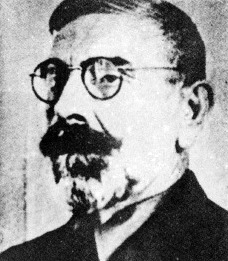
Pavelić arrived in Buenos Aires on 6 November 1948 aboard the Italian merchant ship Sestriere, where he initially resided with the former Ustaše member and writer Vinko Nikolić. In Buenos Aires, Pavelić was joined by his son Velimir and daughter Mirjana. Soon after, his wife Maria and older daughter Višnja also arrived. Pavelić took up employment as a security advisor to Argentinian president Juan Perón. Pavelić's arrival documents show the assumed name of Pablo Aranjos, which he continued to use. In 1950, Pavelić was granted amnesty and permitted to remain in Argentina along with 34,000 other Croats, including former Nazi collaborators and those who had fled from the Allied advance. Following this, Pavelić reverted to his earlier pseudonym Antonio Serdar and continued to live in Buenos Aires. According to Robert B. McCormick, the Vatican viewed Pavelić as a man who had made mistakes but had fought for a just cause.
As was the case for most other political immigrants in Argentina, life was challenging, and Pavelić had to work, including as a bricklayer. His best contact with the Peróns was another former Ustaše member, Branko Benzon, who enjoyed good relations with Evita Perón, the president's wife. Benzon had briefly served as the Croatian ambassador to Germany during World War II and had personally known Hitler, which benefited Croatian-German relations. Thanks to Benzon's friendship with Evita Perón, Pavelić became the owner of an influential building company. Not long after arriving, he joined the Ustaše-related "Croatian Home Guard" (Hrvatski domobranCroatian) organization.
By the end of the 1940s, many former Ustaše members distanced themselves from Pavelić, believing that Croats, under new circumstances, required a new political direction. Many who split from Pavelić continued to identify as Ustaše and sought the revival of the Independent State of Croatia. The most prominent of these separatists was the former Ustaše officer and head of the NDH concentration and extermination camp network, Vjekoslav Luburić, who resided in Spain. In Argentina, Pavelić utilized the "Croatian Home Guard" to gather Croatian political emigrants. Pavelić attempted to expand the activities of this organization, and in 1950, he founded the Croatian Statehood Party, which ceased to exist that same year.
On 10 April 1951, the 10th anniversary of the Independent State of Croatia, Pavelić announced the formation of the Croatia State Government. This new government considered itself a government in exile. Other Ustaše emigrants continued to arrive in Argentina, uniting under Pavelić's leadership and increasing their political activities. Pavelić himself remained politically active, publishing various statements, articles, and speeches in which he claimed that the Yugoslav Communist regime promoted Serbian hegemony.
In 1954, Pavelić met with Milan Stojadinović, a former Royal Yugoslav Prime Minister, who also lived in Buenos Aires. Their meeting aimed to find a solution for historical reconciliation between Serbs and Croats. The meeting stirred controversy but had no practical significance. On 8 June 1956, Pavelić and other Ustaše immigrants founded the Croatian Liberation Movement (Hrvatski oslobodilački pokretCroatian or HOP), which aimed to re-establish Nazism and the NDH. The HOP viewed itself as "a determined adversary of communism, atheism and Yugoslavism in any possible form."
5.3. Assassination attempt and death
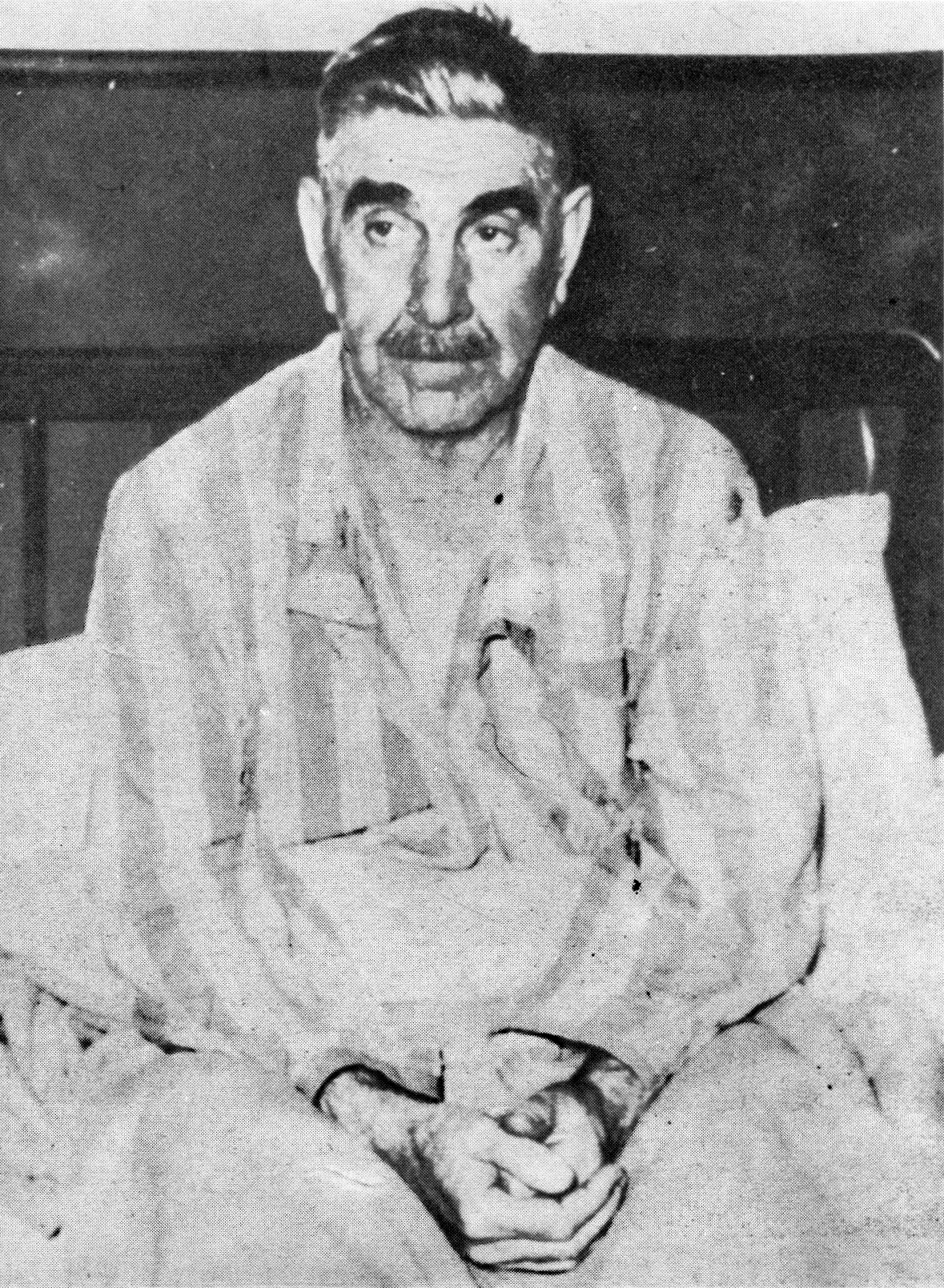
On 10 April 1957, the 16th anniversary of the founding of the Independent State of Croatia, Pavelić was grievously wounded in an assassination attempt by the Serbian Blagoje Jovović, a hotel owner and former Royal Yugoslav officer who had served in the Montenegrin Chetniks during the war. Jovović had attempted to assassinate Pavelić multiple times, planning it as early as 1946, when he learned Pavelić was in hiding inside the Vatican. Jovović shot Pavelić in the back and collar bone as the latter was exiting a bus in El Palomar, a Buenos Aires suburb near his home. Pavelić was transferred to the Syrian-Lebanese hospital, where his true identity was established.
After Perón's fall from power, Pavelić fell out of favor with the Argentine government, and Yugoslavia again requested his extradition. Pavelić refused to remain in the hospital, despite a bullet being lodged in his spine. Two weeks after the shooting, as the Argentine authorities agreed to grant the Yugoslav government's extradition request, he moved to Chile. He spent four months in Santiago before relocating to Spain. Reports circulated that Pavelić had fled to Paraguay to work for the Stroessner regime; his Spanish asylum became known only in late 1959.
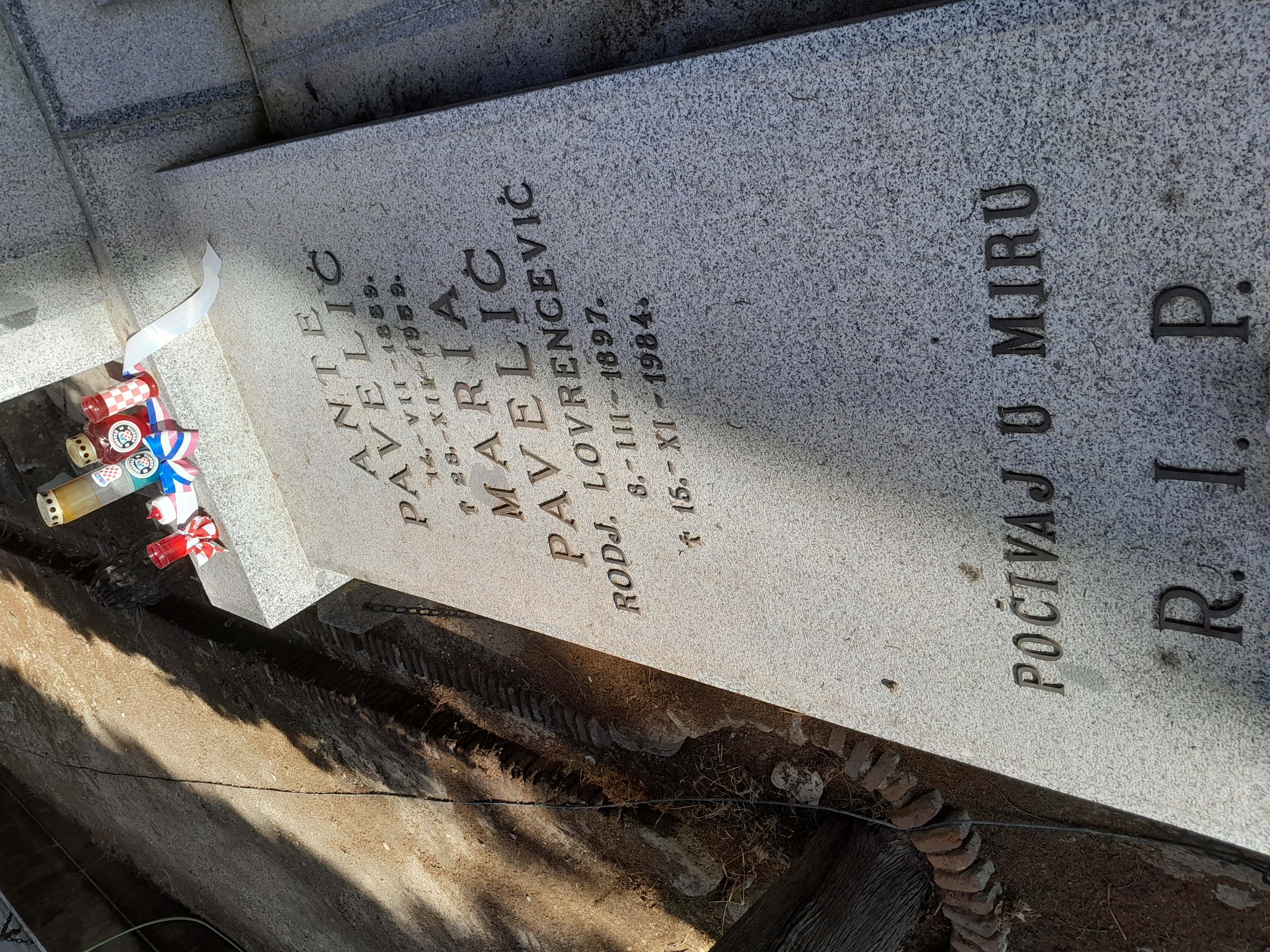
Pavelić arrived in Madrid on 29 November 1957. He continued contacts with members of the Croatian Liberation Movement and received visitors from around the world. Pavelić lived secretly with his family, likely by agreement with the Spanish authorities. Although he was granted asylum, the Spanish authorities did not permit him public appearances. In mid-1958, he sent a message from Madrid to the Assembly of Croatian Societies in Munich. He expressed his wish that all Croats unite with the goal of re-establishing the Independent State of Croatia. Some groups distanced themselves from Pavelić, and others did so after his death. In his will, he named Stjepan HeferCroatian as his successor as the president of the Croatian Liberation Movement. Pavelić died on 28 December 1959 at the Hospital Alemán in Madrid at the age of 70 from the wounds he sustained in the assassination attempt by Jovović. He was buried in San Isidro Cemetery, Madrid's oldest private burial ground.
6. Historical assessment and legacy
6.1. Evaluation of Pavelić's leadership
Scholarly and historical assessments of Ante Pavelić consistently portray him as a ruthless and ideologically driven dictator. His leadership of the Independent State of Croatia was characterized by absolute power, a complete disregard for democratic principles, and the systematic implementation of policies aimed at ethnic and political cleansing. Historians emphasize his central role as the chief instigator of widespread atrocities, including genocide. His political acumen was primarily directed towards consolidating his dictatorial control and aligning his regime with the Axis powers, even at the cost of significant territorial concessions and the suffering of his own population. Pavelić's actions demonstrated a profound commitment to an extreme, exclusionary form of Croat nationalism, which he pursued through terror and violence.
6.2. Criticism and controversy
Ante Pavelić and the Ustaše regime are widely condemned for their egregious war crimes, genocide, and severe human rights violations. The regime's policies led to the deaths of hundreds of thousands of Serbs, Jews, Roma, and anti-fascist Croats and Bosniaks. The establishment and operation of concentration camps like Jasenovac stand as stark symbols of the regime's brutality. Historical debates continue to surround his legacy and the actions of the NDH, with scholars and human rights organizations consistently highlighting the regime's unparalleled barbarity in wartime Europe. Pavelić remains a deeply controversial figure, reviled for his role in one of the most disastrous episodes in Yugoslav history, marked by systematic dehumanization and mass murder.
6.3. Impact on Croatian and Balkan history
The actions of Ante Pavelić and the NDH regime left a profound and lasting impact on Croatian national identity, inter-ethnic relations in the Balkans, and the post-war historical and political landscape. The regime's genocidal policies exacerbated deep-seated ethnic divisions, contributing to decades of mistrust and conflict in the region. The legacy of the Ustaše continues to be a contentious issue in contemporary Croatian society, influencing debates about national memory, historical revisionism, and the complexities of wartime collaboration. His rule remains a dark chapter, fundamentally shaping the trajectory of Croatia and the wider Balkan region through the trauma of mass violence and the enduring challenge of confronting a difficult past.
7. Personal life
7.1. Family and marriage
On 12 August 1922, Ante Pavelić married Maria Lovrenčević at St. Mark's Church, Zagreb. Maria had Jewish ancestry through her mother's family, and her father, Martin Lovrenčević, was a member of the Party of Rights and a well-known journalist. Together, Ante and Maria had three children: two daughters, Višnja and Mirjana, and a son, Velimir.
8. In popular culture
Ante Pavelić and the Ustaše regime have been depicted in various forms of popular culture, reflecting historical interpretations, controversies, and the enduring impact of his figure.
In Harry Turtledove's short story Ready for the Fatherland, set in an alternate history where the Independent State of Croatia continues to exist in 1979, Pavelić is revered as the first Poglavnik, and his image appears on the State's primary currency. However, no further details are shared about how his life unfolded in that timeline, which diverged from ours in February 1943.
In the 2015 Croatian comedy film National Hero Lily Vidić, Pavelić is portrayed by Dražen Čuček. The movie follows a group of Yugoslav partisans, led by a young poet Lily Vidić, who participate in the NDH's fictional talent show "Factor X." The winner is promised a chance to perform at Pavelić's reception for Hitler, which the partisans view as an opportunity to assassinate both Hitler and Pavelić, thereby ending World War II. In 2017, the movie was adapted into a theatrical play, with Boris Mirković portraying Pavelić.